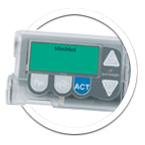

Diabetes Treatment


[Type I]
[Type II]
[Gestational]
Medications
Back to Diagnosis and Treatment Mainpage
People with diabetes typically see specialists such as ophthalmologists for eye examinations (due to increased risks of diabetes retinopathy), podiatrists for routine footcare (assessment of any lesions), dieticians, and endocrinologists.
Maintaining blood glucose levels within the normal range is important for all types of diabetes. When blood glucose levels drop too low, a condition known as hypoglycemia, a person can become dizzy, nervous, confused, and develop impaired judgement. Eventually, the person may faint. Likewise, a high blood glucose level, hyperglycemia, can make a person very sick, as occurs in nondiagnosed diabetics. Treatment should be customized to fit each individual's needs.
Plasma Glucose Monitoring- Glucose levels must be consistently monitored by the patient. A popular at-home technique involves the use of a spring-powered lancet to prick the fingertip and an analyzer. Monitoring glucose levels is especially important before and after meals, but it is also done before bedtime.
Glycosylated Hemoglobin (Hb A1c)- Physicians test Hb A1c levels in patients in order to estimate plasma glucose levels in patients during the preceding months. The normal Hb A1c level is about 6%, though patients with poor plasma glucose monitoring show levels up to 12%.
Type I- Healthy eating is perhaps one of the most obvious and effective ways to treat Type I diabetes, along with injections of insulin or an insulin pump. It is important that blood glucose levels are consistently moniterd, nonroutine physical activity or food intake.

Pictured here is a standard lightweight electronic insulin pump which
delivers insulin through a small syringe into the outer layers of skin
of the abdomen at specified intervals. (http://www.Minimed.com)
Type II- Also
known as non-insulin-dependent-diabetes mellitus (NIDDM) Type II diabetes
also requires healthy eating habits, physical activity, and frequent blood
glucose level testing. The pancreas produces enough insulin in patients
with Type II diabetes, but for unknown reasons the body does not utilize
its glucose (a disorder known as insulin resistance). Thus many Type
II patients use oral medications
and/or insulin to regulate their blood glucose levels.
Gestational-
Since
the mother's hormones are acting to block the action of her insulin (insulin
resistance) in gestational diabetes, she may need almost 3 times as much
insulin as in a normal pregnancy. Treatment usually involves special
meal plans and regular physical activity, as well as blood glucose testing
and insulin injections in order to maintain a normal blood glucose level

Join the Ride
Against Diabetes in
the Tour
de Cure
[Back to Top]
Back to Diagnosis and Treatment Mainpage
Back to Diabetes Mellitus Index
page by Jeff Klomp